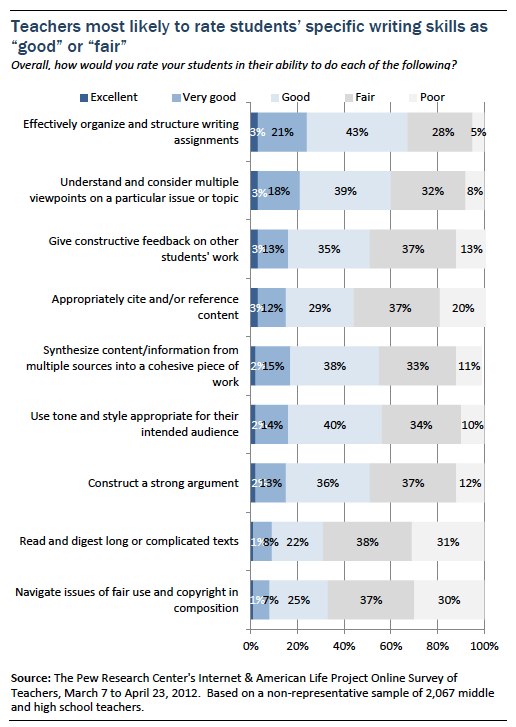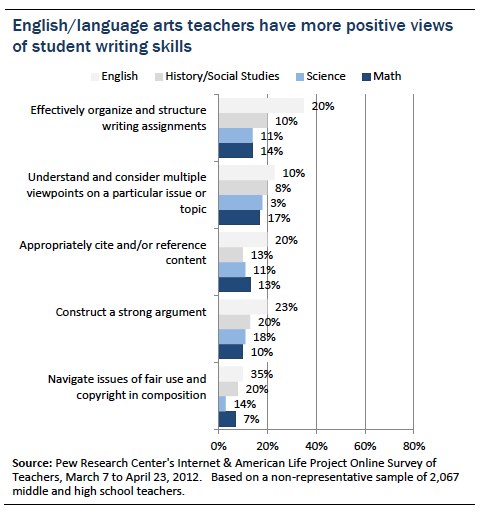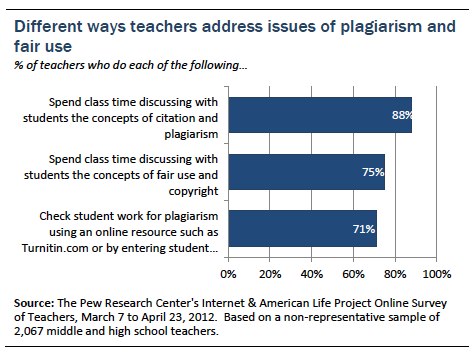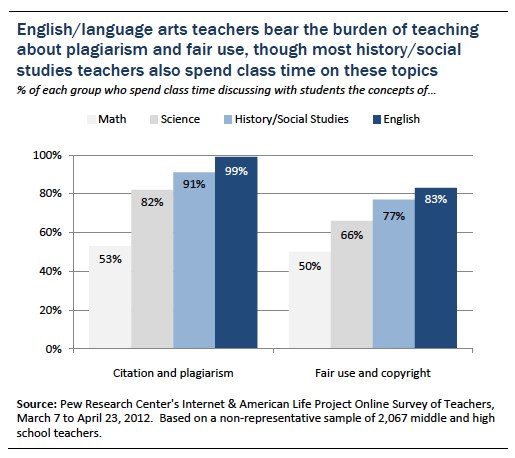Asked to assess their students’ current writing skills, these AP and NWP teachers give students modest ratings. Despite seeing many positive effects of today’s digital tools on student writing, teachers rate the actual writing skills of their students as “good” or “fair” in most cases, rather than “excellent” or “very good.” On each of nine specific writing skills asked about, a majority of these middle and high school teachers rate students “good” or “fair,” indicating most view their students’ writing skills as average and needing improvement.
Teachers rate most students’ writing skills “good” or “fair”
Of nine specific skills asked about in the survey, AP and NWP teachers rated students highest on their ability to “effectively organize and structure writing assignments.” About one-quarter of these teachers describe their students as very good (21%) or excellent (3%) when it comes to this aspect of writing. In addition, about one in five teachers rate their students very good (18%) or excellent (3%) when it comes to “understanding and considering multiple viewpoints on a particular topic or issue.” Yet even for these top rated skills, more teachers describe their students’ performances as “fair” or “poor” than as “very good” or “excellent.” This was true of all nine writing skills asked about in the survey—more teachers rate their students at the bottom of the scale than at the top.
Of particular concern to these teachers is their students’ ability to “read and digest long or complicated texts” and to “navigate issues of fair use and copyright in composition.” On both of these measures, more than two-thirds of AP and NWP teachers in the sample describe their students’ performance as “fair” or “poor.” In addition, 57% of these teachers rate students “fair” or “poor” on “appropriately citing and/or referencing content,” and half give their students low ratings on “giving constructive feedback on other students’ work” and “constructing a strong argument.”

When it comes to rating students’ writing skills, it is the English/language arts teachers among this sample of AP and NWP teachers who again have a more positive view. They were more likely than teachers of other subjects to give their students ratings of “excellent” or “very good” on most of the specific writing skills asked about.

A large majority of AP and NWP teachers surveyed devote class time to teaching about fair use, copyright, and citation
As noted above, the skill for which these AP and NWP teachers give students the lowest rating is “navigating issues of fair use and copyright in composition” and most of these teachers also rate their students “fair” or “poor” on their ability to “appropriately cite and/or reference content.” With so much material available publicly in digital form, the temptation for students to copy and paste others’ work into their own is a concern for many teachers, as is the difficulty many students have discerning the source of material they find online and citing that source correctly.
Clearly, AP and NWP teachers feel students need to improve in these areas, and large majorities are devoting class time to developing these skills. Across teachers of all subjects, 88% spend class time discussing with students the concepts of citation and plagiarism, and 75% report using class time to discuss the concepts of fair use and copyright. The focus and time spent on these issues reflects not only one of the key skills teachers say students need to improve, but also one of the unique challenges these educators face teaching writing in the digital age.

While overall, large majorities of this group of AP and NWP teachers report spending class time teaching about both fair use and plagiarism, the burden falls mainly to English/language arts teachers. Virtually all of the English/language arts teachers surveyed (99%) spend class time teaching their students about plagiarism and proper citation, while 83% work with students on understanding the concepts of fair use and copyright.

AP and NWP teachers discuss the issues of plagiarism and citation…
[students]
Whether accidental or blatantly intentional, there is a tremendous disconnect with how to correctly use and cite outside research. I’m very much at a loss for this quagmire as well.
The biggest challenge has been getting them to analyze sources for credibility. Also, citation and plagiarism are issues. It seems because the information is so freely found, copied, and pasted, students don’t stop to think about what needs to be cited.
The media person has put together a ppt on plagiarism, so the first two days of the semester, we spend time going over these two topics so we are all on the same page. (We have a two day drop and add period then). In a perfect world, the students would come to us with these skills, but in reality they don’t have them.
What everyone else has stated is what I believe. Being able to verify the accuracy of the sources is important. Students use the first few sites they come across and don’t verify the information from additional sites. They should start learning this during elementary school so by the time they get to high school, it becomes second nature. The other part is being able to put this material into their own words. Everyone, including parents, believe that copying and pasting into a report is doing research, even after the concept of plagiarism is explained to them.
[about plagiarism and fair use]
Amazingly, I think students understand things a whole lot better than we teachers often give them credit. Students intimately understand the desire to be given credit for what they produce. Starting from that recognition helps solve most problems from the start. I definitely address issues of fair-use, where appropriate and have spent a lot of time over the last few years invested in deepening my own understanding on this. There continues to be so much misinformation and misunderstanding on copyright issues.
Nearly all plagiarism issues that I have encountered are more learning experiences than efforts to get over on anyone. The incidents have more to do with subtle distinctions. The biggest issue I see is that there are too many tasks given to students that are invitations to plagiarize. I try really hard to create tasks and assignments that require more of them, synthesizing something new. Approaching things in that way preemptively addresses a lot of copyright and plagiarism issues.
We talk about this as we design projects together; we keep track of sources; we give increasingly detailed credit as we learn how and why to recognize others’ contributions to our works. We talk about how much more likely we are to plagiarize when we don’t understand what we’re reading, so we work hard to find texts that make sense to us and that we can paraphrase and credit.
In focus group discussions, teachers disagreed as to whether most plagiarism and violations of fair use are conscious choices to misuse content based on willful disregard or laziness, or if these concepts are generally misunderstood by well-meaning students. Some AP and NWP teachers questioned their own understanding of these complicated and ever-changing concepts—as well as the norms that stem from them—and said they were not surprised to see middle and high school students struggle with them.
Many AP and NWP teachers in the sample also use digital tools to combat plagiarism among their students
The AP and NWP teachers surveyed also note the value of digital tools in helping them detect and combat plagiarism by their students. This “digital monitoring” can be done in many ways, the most common being requiring students to submit all assignments in digital form so that they can be easily checked for lifted passages using tools such as Turnitin.com. Survey data reveal that 71% of this group of AP and NWP teachers check student work for plagiarism using tools like Turnitin.com and/or entering student text into search engines.
AP and NWP teachers discuss using digital tools to combat plagiarism…
I give them essay prompts where they’re required to have at least three bibliographical entries. They then submit their work through turnitin to check for plagiarism. Since I have juniors and seniors, they come to me with whatever research skills they’ve acquired in their English classes.
Going online, typing in key words, and finding so many different sources makes research so much easier today. But sometimes I long for the days of going to the library and actually doing research by looking up information, reading, taking notes and then writing things in your own words. At least you know that the students did much of the work themselves. It is too easy to just cut and paste somebody’s work and call it your own. Even with great programs like turnitin which allows you to check authenticity, the concept of research today is not what it used to be.
Our English teachers have really led the charge on teaching good research habits (thank you to all English teachers!), I only need to echo what they’ve learned from their English teachers and remind them of academic honesty and turning in a product that is really their own. The English teachers have been wonderful about teaching students to distinguish reliable sources from those that are not, and knowing to use sites with .edu and .org as a starting point. Knowing that I will check their work for plagiarism and there will be severe consequences for the grade if there is plagiarism helps students take seriously the task of making a product that is original work.
My gut instinct tells me that resources like turnitin.com aren’t solutions, but band aids. Personally, I tend not to opt for the scare tactic…”if you plagiarize I’ll catch you!” Again, I’d rather have them research and write in smaller chunks more often about different subjects–teach the skill, make it manageable and recursive. As an 8th grade teacher I feel responsible for the skill – practice with the larger research project or paper can come later.
When I first started teaching at the middle school level, our media specialist came in and delivered an awesome lesson on fair use and plagiarism. Now, with budget cuts, that service is not provided. When I begin our research project in the spring, I take time to discuss with my students what plagiarism is and how I can find it within their papers. Fair use is addressed when the issue comes up in class. Our school doesn’t have the funding to use an online resource such as turnitin.com. I simply type in a few words of a student’s paper if I suspect plagiarism. Usually I can find if they have been plagiarizing.
It is kind of interesting, the only time I have had a real problem with plagiarism is when the student felt so short on time and feels completely under pressure to perform that they feel as though cheating is the only way. We do talk about fair use and plagiarism in my classroom, but I have found my students, the few who have done it, to be pretty poor plagiarizers. I usually recognize it pretty quick and can copy and paste it just into Google and it will pop up.
While technology is great and has given students access to much more information, I am concerned with the information overload students encounter. Too many sources available, too much information, and students need to learn better how to evaluate a source to determine whether or not it is valid and reliable. I also yearn for days when kids would use the good old periodical guides in the library. Kids are much more likely to download and print sources and then highlight passages instead of taking notes over sources. And yes, many merely cut and paste passages into their papers and try to pass it off as their own. Thankfully our school uses TurnItIn and this helps catch those plagiarizers pretty well.




